Der Markt für Elektroschiffe hatte im Jahr 2021 einen Wert von 3,82 Milliarden US-Dollar und dürfte von 2021 bis 2028 mit einer durchschnittlichen jährlichen Wachstumsrate von 10,3 % wachsen.
Ein Elektroboot ist jedes Boot oder Schiff, dessen primäre Antriebstechnologie ein elektrisches Antriebssystem ist. Es kann ein voll batteriebetriebenes Elektroboot oder -schiff, ein mit Wasserstoff-Brennstoffzellen betriebenes Elektroboot oder -schiff oder ein Elektrohybridboot sein, von Schleppern, Fähren, Frachtschiffen und Lastkähnen bis hin zu Ausflugsbooten, Fischkuttern, Kreuzfahrtjachten und unbemannten Unterwasserfahrzeugen (UUVs). Elektroschiffe werden im Gegensatz zu herkömmlichen Dieselmotorschiffen elektrisch angetrieben. Diese Schiffe verwenden einen Batteriespeicher als Stromquelle zum Antrieb von Elektromotoren. In einem Elektroschiff können zahlreiche Batterietypen verwendet werden, darunter Lithium-Ionen-Batterien, Blei-Säure-Batterien und Brennstoffzellen. Elektroschiffe sind hauptsächlich Fähren und kleine Passagierschiffe auf Binnenwasserstraßen, die vollständig mit Strom fahren. Sie legen nur kurze Strecken zurück, etwa 80 km mit einer einzigen Ladung. Darüber hinaus werden solarbetriebene Schiffe auch in Leichtschiffen verwendet, die eine geringe Leistungsabgabe benötigen. Der Leistungsbedarf von Frachtschiffen kann jedoch aufgrund ihres hohen Gewichts nicht durch ein vollelektrisches System gedeckt werden; daher verwenden Frachtschiffe ein hybrides dieselelektrisches System.
Passen Sie diesen Bericht Ihren Anforderungen an
Sie erhalten kostenlose Anpassungen an jedem Bericht, einschließlich Teilen dieses Berichts oder einer Analyse auf Länderebene, eines Excel-Datenpakets sowie tolle Angebote und Rabatte für Start-ups und Universitäten.
- Holen Sie sich die wichtigsten Markttrends aus diesem Bericht.Dieses KOSTENLOSE Beispiel umfasst eine Datenanalyse von Markttrends bis hin zu Schätzungen und Prognosen.
Auswirkungen der COVID-19-Pandemie auf den Markt für Elektroschiffe
Die COVID-19-Pandemie hat sich negativ auf den Markt für Elektroschiffe ausgewirkt . Die Pandemie hatte beispiellose globale Auswirkungen auf die menschliche Mobilität. Auf dem Meer sind schiffsbasierte Aktivitäten aufgrund starker Einschränkungen der menschlichen Bewegungsfreiheit und Änderungen beim Warenkonsum beeinträchtigt. Einige Länder haben ihre Kreuzfahrtindustrie aufgrund der COVID-19-Pandemie geschlossen. Einige Kreuzfahrtlinien versuchen jedoch, ihre Aktivitäten während der Pandemie wieder aufzunehmen. Die menschlichen Aktivitäten auf dem Meer wurden durch die COVID-19-Pandemie radikal verändert. Berichte über Hafenbeschränkungen und Änderungen der Konsummuster wirken sich auf mehrere maritime Sektoren, Fischereien, Passagierfähren und Kreuzfahrtschiffe aus. In einigen Regionen wurde der Warentransport während des Lockdowns jedoch für unverzichtbar erklärt, was eine lukrative Gelegenheit für den Markt für Elektroschiffe darstellte.
Markteinblicke für Elektroschiffe
Zunehmender Einsatz von Hybrid- und Elektroantrieben zur Nachrüstung von Schiffen
Die Nachrüstung von Schiffen wird immer interessanter und zieht Reeder/Schiffbauer an, die die Lebensdauer ihrer bestehenden Schiffe verlängern möchten. Ein solcher Prozess bietet die Möglichkeit, den Kraftstoffverbrauch zu senken und auf dem neuesten Stand der umweltfreundlichen Lösungen zu bleiben, und das auf kostengünstige Weise. Nachrüstungen werden in der Schifffahrtsindustrie zu einer gängigen Praxis. Schiffbauer bewegen sich in Richtung Automatisierung, integrieren neu gebaute Schiffe und rüsten bestehende Schiffe mit Hybrid- und Elektroantriebssystemen nach. Dieses System ist eine praktische Wahl für die Nachrüstung veralteter Schiffe mit enormem Nachrüstpotenzial, darunter Fähren, Containerschiffe, Kreuzfahrtschiffe, Schlepper und Stückgutschiffe. Schiffbauer entscheiden sich für die Nachrüstung von Schiffen mit einem Hybrid-Elektroantriebssystem oder einem vollelektrischen Antriebssystem, da dies eine relativ kostengünstigere Option ist als der Kauf eines neuen Schiffes. Darüber hinaus rüsten mehrere europäische Schiffbauer ihre aktuelle Schiffsflotte aktiv mit Hybrid- und Elektroantriebssystemen nach. Laut einem im März 2020 von Riviera Maritime Media Ltd veröffentlichten Artikel investierten die Eigentümer von Offshore-Versorgungsschiffen (OSV) beispielsweise in die Nachrüstung dieselelektrischer/LNG-betriebener Flotten mit batteriebetriebenen Hybridantrieben – ein Schritt, der sich für den Charterer, den Eigentümer und die Umwelt in Norwegen auszahlt. Diese Faktoren haben zur Einführung von Hybrid- und Elektroantriebssystemen für die Nachrüstung von Schiffen geführt.
Typbasierte Markteinblicke
Der Markt für Elektroschiffe ist nach Typ in batteriebetriebene Elektroschiffe, Plug-in-Hybrid-Elektroschiffe und Hybrid-Elektroschiffe unterteilt. Das Segment der Hybrid-Elektroschiffe war im Jahr 2020 Marktführer. Die Zuverlässigkeit von Hybrid-Elektroschiffen unterstützt ihre Nachfrage aufgrund der Verwendung zusätzlicher Antriebssysteme und der höheren Geschwindigkeit, wodurch das Ausfallrisiko verringert und größere Entfernungen in kürzerer Zeit zurückgelegt werden können. Außerdem kann der Antrieb von Hybrid-Elektroschiffen auf zwei Arten erfolgen: elektrisch (über Diesel-Elektro oder Batteriebetrieb) oder mechanisch (direkter Dieselantrieb). Darüber hinaus bevorzugen Schiffseigner oder Schifffahrts- und Logistikunternehmen auf der ganzen Welt Hybrid-Elektroschiffe, da sie einen geringeren Kraftstoffverbrauch ermöglichen und zur Senkung der Betriebskosten beitragen. Der Einsatz von dieselelektrischem Antrieb bei geringer Leistung und direktem Dieselantrieb bei Bedarf an hoher Leistung, d. h. Binnengewässerfahrten mit unterschiedlichen Geschwindigkeitsbedingungen, ermöglicht eine Senkung der Betriebskosten des Elektroschiffs. Dies ist eine intelligentere Möglichkeit, die verfügbare Energie zu nutzen und durch den Einsatz eines Hybrid-Elektroschiffantriebs Kraftstoffkosten zu sparen.
Akteure auf dem Markt für Elektroschiffe verfolgen Strategien wie Fusionen, Übernahmen und Marktinitiativen, um ihre Position auf dem Markt zu behaupten. Nachfolgend sind einige Entwicklungen der wichtigsten Akteure aufgeführt.
- Im November 2021 brachte BAE Systems ein Energie- und Antriebssystem der nächsten Generation auf den Markt, das Schiffsbetreibern dabei helfen soll, emissionsfrei zu fahren. Es bietet eine flexible Lösung, die die elektrische Effizienz und die Reichweite des Schiffes verbessert, die Antriebsleistung erhöht und die Installation vereinfacht.
- Im September 2020 unterzeichneten Kolumbus (ein Mobilitätsunternehmen) und Fjellstrand (Schiffsbauer) einen Vertrag zur Lieferung der weltweit ersten vollelektrischen Schnellfähre. Dieses Projekt wurde aus dem Forschungs- und Innovationsprogramm Horizont 2020 der Europäischen Union finanziert.
Basierend auf dem Typ ist der Markt für Elektroschiffe in batteriebetriebene Elektroschiffe, Plug-in-Hybrid-Elektroschiffe und Hybrid-Elektroschiffe unterteilt. Basierend auf der Leistung ist der Markt für Elektroschiffe in weniger als 75 kW, 75–150 kW, 151–745 kW, 746–7560 kW und mehr als 7560 kW unterteilt. Basierend auf der Reichweite ist der Markt für Elektroschiffe in weniger als 50 km, 50–100 km, 101–1000 km und mehr als 1000 km unterteilt. Basierend auf dem Schiffstyp ist der Markt für Elektroschiffe in Kreuzfahrtschiffe, Fähren, Tanker, Massengutfrachter, Fischereifahrzeuge, Zerstörer, Flugzeugträger und andere unterteilt. Geografisch ist der Markt für Elektroschiffe in fünf Hauptregionen unterteilt: Nordamerika, Europa, Asien-Pazifik (APAC), Naher Osten und Afrika (MEA) und Südamerika (SAM).
Regionale Einblicke in den Markt für Elektroschiffe
Die regionalen Trends und Faktoren, die den Markt für Elektroschiffe im Prognosezeitraum beeinflussen, wurden von den Analysten von Insight Partners ausführlich erläutert. In diesem Abschnitt werden auch die Marktsegmente und die Geografie von Elektroschiffen in Nordamerika, Europa, im asiatisch-pazifischen Raum, im Nahen Osten und Afrika sowie in Süd- und Mittelamerika erörtert.

- Holen Sie sich die regionalen Daten für den Markt für Elektroschiffe
Umfang des Marktberichts für Elektroschiffe
| Berichtsattribut | Details |
|---|---|
| Marktgröße im Jahr 2021 | 3,82 Milliarden US-Dollar |
| Marktgröße bis 2028 | 7,76 Milliarden US-Dollar |
| Globale CAGR (2021 - 2028) | 10,3 % |
| Historische Daten | 2019-2020 |
| Prognosezeitraum | 2022–2028 |
| Abgedeckte Segmente | Nach Typ
|
| Abgedeckte Regionen und Länder | Nordamerika
|
| Marktführer und wichtige Unternehmensprofile |
|
Dichte der Marktteilnehmer für Elektroschiffe: Auswirkungen auf die Geschäftsdynamik verstehen
Der Markt für Elektroschiffe wächst rasant, angetrieben durch die steigende Nachfrage der Endnutzer aufgrund von Faktoren wie sich entwickelnden Verbraucherpräferenzen, technologischen Fortschritten und einem größeren Bewusstsein für die Vorteile des Produkts. Mit steigender Nachfrage erweitern Unternehmen ihr Angebot, entwickeln Innovationen, um die Bedürfnisse der Verbraucher zu erfüllen, und nutzen neue Trends, was das Marktwachstum weiter ankurbelt.
Die Marktteilnehmerdichte bezieht sich auf die Verteilung der Firmen oder Unternehmen, die in einem bestimmten Markt oder einer bestimmten Branche tätig sind. Sie gibt an, wie viele Wettbewerber (Marktteilnehmer) in einem bestimmten Marktraum im Verhältnis zu seiner Größe oder seinem gesamten Marktwert präsent sind.
Die wichtigsten auf dem Markt für Elektroschiffe tätigen Unternehmen sind:
- BAE Systems
- Duffy Elektroboot-Unternehmen
- Fjellstrand AS
- X Shore
- Elektroboot von General Dynamics
Haftungsausschluss : Die oben aufgeführten Unternehmen sind nicht in einer bestimmten Reihenfolge aufgeführt.

- Überblick über die wichtigsten Akteure auf dem Markt für Elektroschiffe
Firmenprofile
- BAE Systems
- Duffy Elektroboot- Unternehmen
- Fjellstrand AS
- X Shore
- Elektroboot von General Dynamics
- Hurtigruten
- MAN Energy Solutions
- PortLiner
- Siemens Energy
- VARD AS
- Historische Analyse (2 Jahre), Basisjahr, Prognose (7 Jahre) mit CAGR
- PEST- und SWOT-Analyse
- Marktgröße Wert/Volumen – Global, Regional, Land
- Branche und Wettbewerbsumfeld
- Excel-Datensatz



Report Coverage
Revenue forecast, Company Analysis, Industry landscape, Growth factors, and Trends

Segment Covered
This text is related
to segments covered.

Regional Scope
North America, Europe, Asia Pacific, Middle East & Africa, South & Central America

Country Scope
This text is related
to country scope.
Häufig gestellte Fragen
The idea of retrofitting ships is gaining interest and is attracting shipowners/shipbuilders to extend the lifetime of their existing ships. Such a process provides a chance to reduce fuel consumption and stay up to date with the latest eco-friendly solutions as a cost-effective procedure. Retrofitting is becoming a common practice in the maritime industry. Shipbuilders are moving toward automation, integrating new build ships, and retrofitting existing ships with hybrid and electric propulsion systems. A hybrid-electric propulsion system is a convenient choice for retrofitting outdated ships. Ships have a large retrofit potential, including ferries, container vessels, cruise ships, tugboats, and general cargo ships. Shipbuilders choose to retrofit ships with a hybrid-electric propulsion system or a fully electric propulsion system as it is a relatively cheaper option than purchasing a new ship. These factors mentioned above have resulted in the adoption of hybrid and electric propulsion systems for retrofitting ships.
Nowadays, hybrid propulsion technology is commonly used for small vessels such as ferries. For instance, according to the article published by the Institution of Engineering and Technology, in January 2019, the UK shipbuilder Ferguson Marine had built Catriona, a £12.3 million (US$ 15.82 million) diesel-electric-battery-power hybrid ferry for CalMac to use on its Clyde and Hebridean routes. However, with the development of marine electric propulsion technology and alternative fuels such as fuel cells, there is a massive opportunity for manufacturers to work on hybrid-electric propulsion systems for larger ships. The stricter emissions targets have encouraged shipbuilders to install a hybrid propulsion system on existing or new vessels. The research & development (R&D) department for ABB marine activities in Norway stated that the hybrid propulsion systems significantly reduce both fuel consumption and emissions, according to the article published by the Institution of Engineering and Technology in January 2019. Therefore, with the growing emission control norms, the adoption of hybrid-electric propulsion systems is increasing among larger ships, creating a massive opportunity for manufacturing larger ships using hybrid-electric propulsion systems.
Europe dominated the Electric Ships market in 2020 with a share of 48.6% and is expected to continue its dominance by 2028. North America is the second-largest contributor to the global Electric Ships market in 2020, followed by Asia Pacific.
The major companies in Electric Ships market are BAE Systems, Duffy Electric Boat Company, Fjellstrand AS, X Shore, General Dynamic Electric Boat, Hurtigruten, MAN Energy Solutions, PortLiner, Siemens Energy, and VARD AS
The major Application in Electric Ships includes cruise ship, ferries, tankers, bulk carriers, fishing vessels, destroyers, aircraft carriers, and others. In terms of market share, the electric ships market was dominated by the ferries segment in 2020.
The electric ships market, by type is segmented into battery electric ships, plug-in hybrid electric ships, and hybrid electric ships. The Electric Ships market was dominated by the hybrid electric ships segment in 2020.
Trends and growth analysis reports related to Automotive and Transportation : READ MORE..
The List of Companies - Electric Ships Market
- BAE Systems
- Duffy Electric Boat Company
- Fjellstrand AS
- X Shore
- General Dynamic Electric Boat
- Hurtigruten
- MAN Energy Solutions
- PortLiner
- Siemens Energy
- VARD AS
The Insight Partners performs research in 4 major stages: Data Collection & Secondary Research, Primary Research, Data Analysis and Data Triangulation & Final Review.
- Data Collection and Secondary Research:
As a market research and consulting firm operating from a decade, we have published and advised several client across the globe. First step for any study will start with an assessment of currently available data and insights from existing reports. Further, historical and current market information is collected from Investor Presentations, Annual Reports, SEC Filings, etc., and other information related to company’s performance and market positioning are gathered from Paid Databases (Factiva, Hoovers, and Reuters) and various other publications available in public domain.
Several associations trade associates, technical forums, institutes, societies and organization are accessed to gain technical as well as market related insights through their publications such as research papers, blogs and press releases related to the studies are referred to get cues about the market. Further, white papers, journals, magazines, and other news articles published in last 3 years are scrutinized and analyzed to understand the current market trends.
- Primary Research:
The primarily interview analysis comprise of data obtained from industry participants interview and answers to survey questions gathered by in-house primary team.
For primary research, interviews are conducted with industry experts/CEOs/Marketing Managers/VPs/Subject Matter Experts from both demand and supply side to get a 360-degree view of the market. The primary team conducts several interviews based on the complexity of the markets to understand the various market trends and dynamics which makes research more credible and precise.
A typical research interview fulfils the following functions:
- Provides first-hand information on the market size, market trends, growth trends, competitive landscape, and outlook
- Validates and strengthens in-house secondary research findings
- Develops the analysis team’s expertise and market understanding
Primary research involves email interactions and telephone interviews for each market, category, segment, and sub-segment across geographies. The participants who typically take part in such a process include, but are not limited to:
- Industry participants: VPs, business development managers, market intelligence managers and national sales managers
- Outside experts: Valuation experts, research analysts and key opinion leaders specializing in the electronics and semiconductor industry.
Below is the breakup of our primary respondents by company, designation, and region:

Once we receive the confirmation from primary research sources or primary respondents, we finalize the base year market estimation and forecast the data as per the macroeconomic and microeconomic factors assessed during data collection.
- Data Analysis:
Once data is validated through both secondary as well as primary respondents, we finalize the market estimations by hypothesis formulation and factor analysis at regional and country level.
- Macro-Economic Factor Analysis:
We analyse macroeconomic indicators such the gross domestic product (GDP), increase in the demand for goods and services across industries, technological advancement, regional economic growth, governmental policies, the influence of COVID-19, PEST analysis, and other aspects. This analysis aids in setting benchmarks for various nations/regions and approximating market splits. Additionally, the general trend of the aforementioned components aid in determining the market's development possibilities.
- Country Level Data:
Various factors that are especially aligned to the country are taken into account to determine the market size for a certain area and country, including the presence of vendors, such as headquarters and offices, the country's GDP, demand patterns, and industry growth. To comprehend the market dynamics for the nation, a number of growth variables, inhibitors, application areas, and current market trends are researched. The aforementioned elements aid in determining the country's overall market's growth potential.
- Company Profile:
The “Table of Contents” is formulated by listing and analyzing more than 25 - 30 companies operating in the market ecosystem across geographies. However, we profile only 10 companies as a standard practice in our syndicate reports. These 10 companies comprise leading, emerging, and regional players. Nonetheless, our analysis is not restricted to the 10 listed companies, we also analyze other companies present in the market to develop a holistic view and understand the prevailing trends. The “Company Profiles” section in the report covers key facts, business description, products & services, financial information, SWOT analysis, and key developments. The financial information presented is extracted from the annual reports and official documents of the publicly listed companies. Upon collecting the information for the sections of respective companies, we verify them via various primary sources and then compile the data in respective company profiles. The company level information helps us in deriving the base number as well as in forecasting the market size.
- Developing Base Number:
Aggregation of sales statistics (2020-2022) and macro-economic factor, and other secondary and primary research insights are utilized to arrive at base number and related market shares for 2022. The data gaps are identified in this step and relevant market data is analyzed, collected from paid primary interviews or databases. On finalizing the base year market size, forecasts are developed on the basis of macro-economic, industry and market growth factors and company level analysis.
- Data Triangulation and Final Review:
The market findings and base year market size calculations are validated from supply as well as demand side. Demand side validations are based on macro-economic factor analysis and benchmarks for respective regions and countries. In case of supply side validations, revenues of major companies are estimated (in case not available) based on industry benchmark, approximate number of employees, product portfolio, and primary interviews revenues are gathered. Further revenue from target product/service segment is assessed to avoid overshooting of market statistics. In case of heavy deviations between supply and demand side values, all thes steps are repeated to achieve synchronization.
We follow an iterative model, wherein we share our research findings with Subject Matter Experts (SME’s) and Key Opinion Leaders (KOLs) until consensus view of the market is not formulated – this model negates any drastic deviation in the opinions of experts. Only validated and universally acceptable research findings are quoted in our reports.
We have important check points that we use to validate our research findings – which we call – data triangulation, where we validate the information, we generate from secondary sources with primary interviews and then we re-validate with our internal data bases and Subject matter experts. This comprehensive model enables us to deliver high quality, reliable data in shortest possible time.


 Holen Sie sich ein kostenloses Muster für diesen Bericht
Holen Sie sich ein kostenloses Muster für diesen Bericht